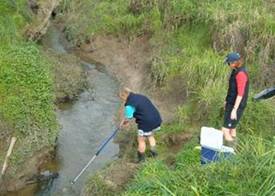12.8 Case study 2 – Otarao catchment study
 Otarao catchment project is a joint project between the NRC, Mangakahia Landcare Group, NZ Landcare Trust and the landowners of the catchment. Otarao catchment is approximately 2500ha in size and is a sub-catchment of the Mangakahia Catchment. Located about 30 minutes west of Whangarei, the catchment has varying land uses including a dairy farm and dairy run-offs, forestry, sheep and beef farms, native bush and lifestyle blocks.
Otarao catchment project is a joint project between the NRC, Mangakahia Landcare Group, NZ Landcare Trust and the landowners of the catchment. Otarao catchment is approximately 2500ha in size and is a sub-catchment of the Mangakahia Catchment. Located about 30 minutes west of Whangarei, the catchment has varying land uses including a dairy farm and dairy run-offs, forestry, sheep and beef farms, native bush and lifestyle blocks.
The purpose of the water quality-monitoring component of the project is to characterise the existing water quality of the catchment, and to identify any issues that may exist. These first few years of monitoring are also important to establish background pre-restoration data that can be compared with post-restoration data.
Five sites have been sampled from 2002 to 2006. The results show that the native forest "unimpacted" site in the headwaters of the catchment has excellent water quality and stream ecological health. On the other hand the bottom site in the catchment, where the Otarao joins the Mangakahia River, frequently has poor water quality because of the cumulative affects of land use throughout the catchment. This bottom site in the catchment has high water temperatures and low dissolved oxygen levels in summer and high nutrient and bacterial levels for most of the year and poor water clarity.
Several landowners have fenced off the Otarao Stream and its tributaries. Also several landowners have had farm management plans mapped for them to improve their farm management, while reducing the environmental effects of farming. Mangakahia Landcare Group, landowners, the local community, NRC and Landcare Trust have held several community planting days to plant native riparian buffers next to the stream. This will enhance biodiversity in the area, as well as improving water quality.
Restoration and enhancement work will continue in the catchment. Currently water quality monitoring is continuing monthly at the bottom site in the catchment to assess long term trends in water quality. However, once more restoration work has been implemented the original sampling programme will be repeated to detect improvements in water quality throughout the catchment.
For more detailed information on the results from the first four years of monitoring check out the following report available on the Regional Council website:
http://www.nrc.govt.nz/Resource-Library-Summary/Research-and-reports/Rivers-and-streams/
